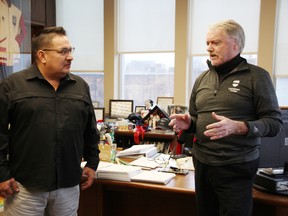
It’s probably best to describe the City of Sarnia and Aamjiwnaang First Nation as “fence-line neighbours,” the First Nation’s chief says.
“Because people get confused thinking that we are part of the City of Sarnia,” Chris Plain said.
Sarnia Mayor Mike Bradley was once among them, saying Sarnia was one of the only communities in Canada with a reserve in its territory before he realized his error.
The reverse is more true, the Sarnia mayor said, “so that’s all been dropped. It’s more focused on the two communities side by side.”
The long-serving community leaders — Bradley mayor since 1988 and Plain chief since 2005, save a 2016-2018 break when he served as a councilor — recently spoke with The Observer about their relationship and that of the communities they serve.
The 1,250-hectare Aamjiwnaang territory is home to about 800 of the band’s 2,500 members, while others live in Sarnia, Port Huron, Mich. or further abroad, Plain said.
Unlike reserves further away from municipal centres, Aamjiwnaang’s territory near Sarnia’s southern border has fire, police, water and sewer service through decades-old agreements with the city.
That means many major issues for other First Nations, like clean drinking water and emergency response for fires, are non-issues here, Plain said.
The community also uses revenue from investments for its own garbage and recycling contracts, as well as infrastructure like its community center and road rehabilitation, while employing about 200 people from Sarnia at its industrial park. Recently, Aamjiwnaang partnered with the city on a joint application for about $7.3 million in federal and provincial funding to upgrade watermains.
“It’s mutually beneficial, and it’s funding that we were able to capitalize on, both communities, by a single source by working together,” Plain said.
There’s also transmission and pipeline right-of-ways through the First Nation territory that benefits others financially, the chief said.
“We’ve got 400,000 barrels of oil that come through and we get $100 a year for it,” he said, adding “we’re looking at different ways now to be able to be involved in those types of transactions, as opposed to just being used which we were for 30, 40 years.”
Plain recently emceed the swearing in of Sarnia’s mayor and council after the October municipal election, when both he and Bradley talked about the importance of the relationship and the communities working together.
They largely ignore an agreement that says they should meet four times per year and just speak whenever the need arises, they said, suggesting it’s far more than the minimum requirement.
There’s also been talk on Sarnia council of formalizing meetings between the councils while their staffs frequently work together already.
But what happens between the councils and the municipal and band offices hasn’t been what’s bolstered the communities’ relationship, Bradley and Plain said.
It’s been more about community groups and organizations engaging with the First Nation, seeking representation for boards, learning about customs and traditions, and implementing policies to make First Nation people feel welcome, Plain said.
“Pretty soon, I think we’re going to run out of members to provide to all of these services because there’s no shortage of activities and programs in our community,” the chief said.
First Nation members who are post-secondary students outnumber the residents on Ontario Works while students learn Ojibwe in school, he said, describing these trends as indications of progress.
“Definitely there was times, and I can clearly say this, that I was treated differently only because of the color of my skin,” Plain said about his time in school.
It’s been different with his children, he added.
“I’ve never had to go to the school to challenge a principal’s decision like my parents had to when I was in school,” Plain said.
That sort of evolution has led to community members feeling safer and becoming more engaged while strengthening the relationship with the city, he said.
The chief also pointed to the local decision to engage in dialogue instead of police intervention when protesters blocked a rail spur years ago during the Idle No More movement, as well as the adoption of territorial acknowledgments.
“I don’t really like the word reconciliation myself,” said Plain, noting some may misinterpret that as meaning something is owed. “But if we’re given the chance, that’s all we really ask for.
“Equal chance to housing, equal chance to justice, equal chance to child welfare, equal chances in every segment of society that we’ve always seemed to be behind barriers.”
There are still barriers in the community, like some First Nation members being denied places to live by landlords, Plain said, noting it’s likely investors from outside the community.
Meanwhile, another sign of progress has been more people coming to the First Nation to participate in events there like Aamjiwnaang Solidarity Day, he said.
“When I was a kid, my friends didn’t come to sleep over, but now I’ve got all kinds of kids getting off the buses on my street and I see them sleeping over at my neighbours’ houses,” he said.
The intent is to continue to have First Nation involvement in the inaugural council ceremonies, as a reminder of the importance of the unique relationship between the communities, Bradley said.
“I would hope they keep that in perpetuity.”
